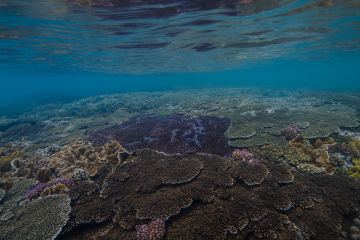Media Release ·
The Great Barrier Reef Foundation’s Reef-saving projects showcased live on the ABC

For the first time Australia will be able to see our Reef-saving research in real-time as five of the Great Barrier Reef Foundation’s more than 60 projects are being showcased as part of the ABC’s Reef Live event.
Our Reef is the largest living thing on Earth, with rich corals spanning an area visible from space.
But it’s facing a growing combination of threats and we’re already seeing the effects in many parts of our Reef. Without help the outlook is bleak, but there is hope
Right now, the Great Barrier Reef Foundation is saving our Reef and its marine life for future generations and for the first time a number of these projects will be showcased live.
You will get a rare chance to see three innovations that are part of the world’s largest coral reefs program (the Reef Restoration and Adaptation Program) which sees the Foundation bringing together people and science to investigate new techniques to restore coral reefs and adapt them at unprecedented scales.
Climate change is here and the time to act to save our Reef is now. The experts agree there is no silver bullet. What’s needed is a range of techniques that work together to not only help the world’s largest Reef, but also support coral reef health across the world and the communities that depend on them.
Techniques such as Coral IVF which is led by Southern Cross University Professor Peter Harrison and is giving nature a helping hand to restore damaged coral populations, which you will be able to see live on ABC’s Reef Live event.
Ever wondered how clouds could help save our Reef? You will get an update on our innovative cloud-brightening project which is looking at whether spraying seawater droplets into the sky can shade reefs on hot days, from Southern Cross University Researcher Daniel Harrison.
You will also have the rare opportunity to take a peek inside the Australian Institute of Marine Science’s National Sea Simulator where Researcher Dr Kate Quigley will show viewers their ground-breaking research into breeding heat resistant corals.
You will also get to see something only a handful of researchers have been able to experience - the world’s largest green turtle nesting area in peak nesting season. Researchers will come to you live from Raine Island surrounded by nesting turtles that are being counted as part of the project which is saving endangered turtles by restoring this critical island.
The Foundation played a leading role to initiate the Raine Island Recovery project which has delivered an additional 640,000 green turtle hatchlings to the Reef and doubled the nesting area since the project began.
“When we rescue an adult turtle and then see that turtle return to lay eggs is amazing. Knowing that I helped to save that turtle from dying and then seeing it back up on the beach nesting means that I have contributed to the future of the green turtle population which is just the most amazing feeling,” said Katharine Robertson, Department of Environment and Science, Queensland Parks and Wildlife – Senior Conservation Officer.
“Because of the Project and the support of the partners involved, each season we are going to see more and more hatchlings which will make a difference to the future of the northern Great Barrier Reef green turtle population.”
We should all be proud that it’s our responsibility to look after our Reef and Reef Live will be highlighting that viewers, no matter where they are in the world, can become citizen scientists through our Virtual Reef Diver project. This is an online platform that provides a unique opportunity to get involved in monitoring the Reef by going onto the website and classifying images according to whether the image is of soft or hard coral, algae, sand or water.
This crowd-sourced information complements scientific data that maps the reefs health and provides managers with a clearer picture to make decisions and focus on areas of the reef that need conservation.
This is just one of the Great Barrier Reef Foundation’s Citizen Science and Local Action programs which have collectively had more than 8,500 participant engagements across the Reef in the last two years.
REEF LIVE is available to view on ABC iview here.
Project information
The Reef Restoration and Adaptation Program is funded by the partnership between the Great Barrier Reef Foundation and Australian Government’s Reef Trust and is delivered by a collaboration between Australian Institute of Marine Science, the Great Barrier Reef Foundation, CSIRO, The University of Queensland, Queensland University of Technology, Southern Cross University and James Cook University.
The Raine Island Recovery project is a collaboration between BHP, the Queensland Government, the Great Barrier Reef Marine Park Authority, the Wuthathi Nation and Meriam Nation (Ugar, Mer, Erub) Traditional Owners and the Great Barrier Reef Foundation.
Virtual Reef Diver is funded by the partnership between the Great Barrier Reef Foundation and The Australian Government’s Reef Trust.
#Reef Chat: Pioneering science to restore reefs
We chatted exclusively with one of the stars of the event, leader in coral reproduction and restoration Southern Cross University Professor Peter Harrison and Australian Institute of Marine Science coral genetics expert Dr Line Bay to find out more about their Reef-saving research and how it’s helping save our Reef as part of the world’s largest coral reefs program.




